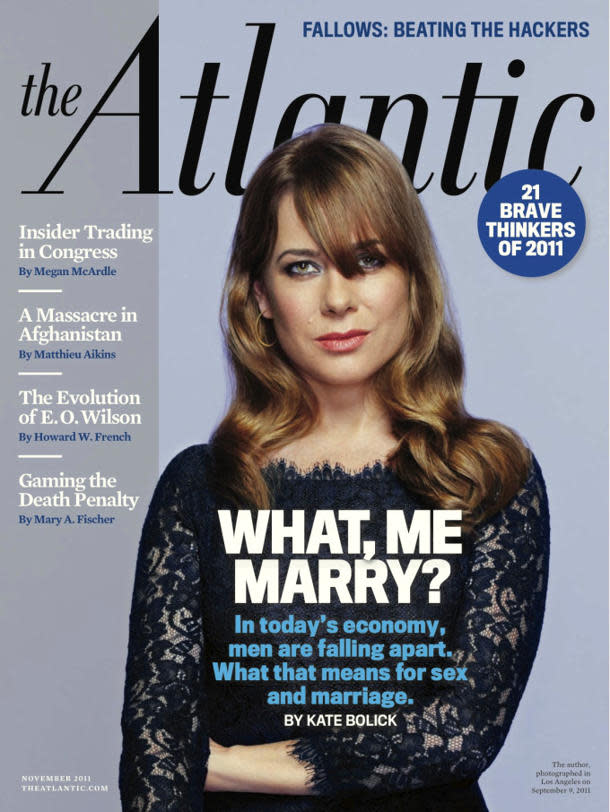 The Cutline
The CutlineVoices unheard: Female bylines still lacking in male-dominated literary magazines
If you think journalism is becoming feminized, following in the footsteps of the nursing and teaching industries, bylines certainly don't show it. In fact, it's quite the opposite.
A year after sparking feminist furor with a study that found a lack of female bylines in literary magazines, the Vida organization has published another annual count. And despite the uproar within the publishing and literary community that last year's study caused, it appears not much has changed.
The non-profit group--founded by a pair of female professors--spent more than two months tallying articles and book reviews from the 2011 issues of 14 publications including The Atlantic, New Yorker, New Republic, New York Times Book Review, New York Review of Books, Harper's, Granta, Paris Review, Poetry magazine, London Review of Books, Boston Review, Threepenny Review, Times Literary Supplement and the Nation.
They found that just 28 percent of the 6,644 articles published by the titles last year were written by women. In all but two categories tracked by Vita--which included writers, reviewers or authors being reviewed across all 14 publications--men dominated the content. And just one publication, Granta, had more women contributors (34) last year than men (30).
"We want to raise people's consciousness," Erin Belieu, Vida co-director and professor at Florida State Univ., told Yahoo News. "Gender bias is pretty ingrained--this is a expression in the literary world, but it happens everywhere."
Of 326 articles published by The Atlantic in 2011, including fiction, just 28 percent were written by women. That ratio was virtually unchanged from 2010, when 25 percent or 52 of 210 articles had female writers.
Of the 36 book authors reviewed in the Atlantic last year, a third were women--a marginally more even ratio than 2010, when just 23 percent or 10 of the 43 authors reviewed were female.
A spokeswoman for the Atlantic declined to comment on the study.
At the New Yorker, 73 percent or 459 of the 624 articles published last year were written by men. The ratio was virtually unchanged from 2010, when 449 of 612 articles published in the magazine were written by men.
A representative for the New Yorker did not return a request seeking comment, either. But following Vida's 2010 study, editor David Remnick told the Jewish Forward, "We've got to do better--it's as simple and as stark as that."
They're certainly not alone.
At the New York Review of Books, a whopping 88 percent--or 133 of 152 articles published in 2011--were written by men. More than 80 percent of the 770 overall pieces published were written by men. (More than three-quarters of the authors reviewed by the publication were male.) In 2010, 85 percent of the articles published by NYROB were written by men, while 84 percent or 306 of 365 authors reviewed were male.
Over 80 percent of the 442 articles published in 2011 by the New Republic were written by men, the study found, while 82 percent of the 92 books reviewed were authored by men. In 2010, 84 percent of the 305 articles published by TNR were written by men, and 86 percent of the 64 authors reviewed were male.
"The numbers tell the story," Belieu said.
The gender gap was closer at the New York Times Book Review, which had 448 male reviewers compared to 368 females in 2011.
"In house [these publications] might be doing a lot to solicit writers, but I don't think they want to draw attention to the problem," Belieu said. "It's a political subject."
Following the publication of Vida's first study, in 2011, Harper's magazine editor Ellen Rosenbush called "the dearth of female bylines" an "industry-wide issue," but planned to change the equation. "I have made it a point to have at least one woman writer in every issue," Rosenbush wrote in response.
"At some of the older, more established publications, it's an uncomfortable belief system, Belieu said. "I think a lot of the major publications hope that this problem would just go away."
Her partner concurred. "There are a lot of women who read these magazines, and they're starting to notice," Cate Marvin, the other co-director, said in a separate interview. "It's a bad business decision, frankly."
The 2011 study has already sparked considerable discussion in the female literary community. It inspired Ann Friedman, the executive editor of Good magazine and the curator of the LadyJournos Tumblr, to do her own count of her first three issues: 25 men, and 25 women. "Proud to be in your company, Granta," Friedman wrote.
"There was no official conversation about this, even though we as women writers talk about it all the time," Belieu said. "And I think we accidentally put our finger on something a lot of people were feeling."
Click here for the full Vida study.
Other popular Yahoo! News stories:
• Does this PETA ad featuring a woman in a neckbrace promote veganism or violence?
• Gloria Allred accidentally reveals her 380-person press list
• Bloomberg Businessweek gives Romney Springsteen's backside

